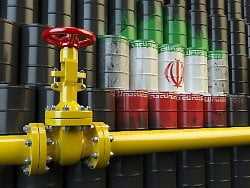Brent scratches the $100 mark
Why there is no panic in the oil market yet
2/22/2022, 4:42 p.m
The worsening of the Ukraine crisis is pushing the oil price dangerously close to the psychologically important $100 mark. Then the climbing stops. There are several reasons for this – one has to do with the Iran negotiations.
The feared horror scenario in the Ukraine conflict between Russia and the West is taking shape: increasing escalation and a possible theater of war could lead to Russia cutting off Europe’s important supply of oil and gas. Ifo President Clemens Fuest expects prices to rise significantly in the event of a Russian invasion of Ukraine. “Even if gas supplies were not restricted, there would be a price shock, at least temporarily,” he said. “That would affect private households and industry in Germany equally.”
Gas prices in Europe rose by six percent. With 38 percent of imports, Russia is the most important supplier of natural gas – for Germany the value is even higher. The increase in commodity prices is primarily fueling investors’ fears of inflation.
Oil prices also rose in response to recent Russian aggression in eastern Ukraine. The price for the market-leading Brent oil futures contract recently rose 0.6 percent to $96.98 – after a daily high of $99.50. The oil price was only a few cents away from the psychologically important mark of 100 dollars, which was last reached seven and a half years ago.
“The potential for a rally above $100 a barrel has received a huge boost,” commented Tamas Varga of oil brokerage PVM. “Those who bet on such a development anticipated the escalation of the conflict.”
The fact that, despite all the provocations and worries, oil prices have still not climbed the sound barrier of 100 US dollars per barrel and instead come back from the daily highs, initially borders on a miracle. But traders are quick to come up with explanations: Among other things, they point to the West’s cautious reaction to the aggression: “The sanctions announced by the West so far are not particularly alarming,” said one market participant.
Many observers seem certain that if sanctions against Russia were tightened, oil and gas supplies would in all likelihood remain unaffected. Russian President Vladimir Putin said gas supplies to Western Europe would continue. After all, Russia is dependent on foreign exchange earnings.
And if the sanctions get tougher?
“I don’t think there will be a total export ban,” said PVM Oil analyst Tamas Varga. But the more important question is how long Russia will keep its feet still and how Putin will react to tightened sanctions? Ultimately, there is nothing that can prevent him from curtailing deliveries, according to the expert. An interruption in Russian oil supplies is also conceivable.
According to traders, however, the market has not yet priced in such scenarios – so there can be no question of panic. The futures contracts with delivery dates later in the current year would trade cheaper than the market-leading contracts. Brent North Sea oil for year-end 2022 delivery is trading at $85.37 per barrel – $12.73 below the market-leading futures expiry February 28, 2022.
Ultimately, traders also explain this phenomenon with the expectation that Iranian oil could increasingly come onto the market in the coming months. The nuclear negotiations with Iran are apparently on the home stretch. It cannot be ruled out that there could be a connection with the threat of sanctions against Russia and the West’s willingness to compromise in the nuclear negotiations with Iran.
“An Iran deal could give the oil market some breathing room,” quoted the “Handelsblatt” as Helima Croft, commodities expert at the investment bank RBC Capital Markets. But negotiations on Iran’s nuclear program and the country’s return to the global oil market have been stalled for months.
